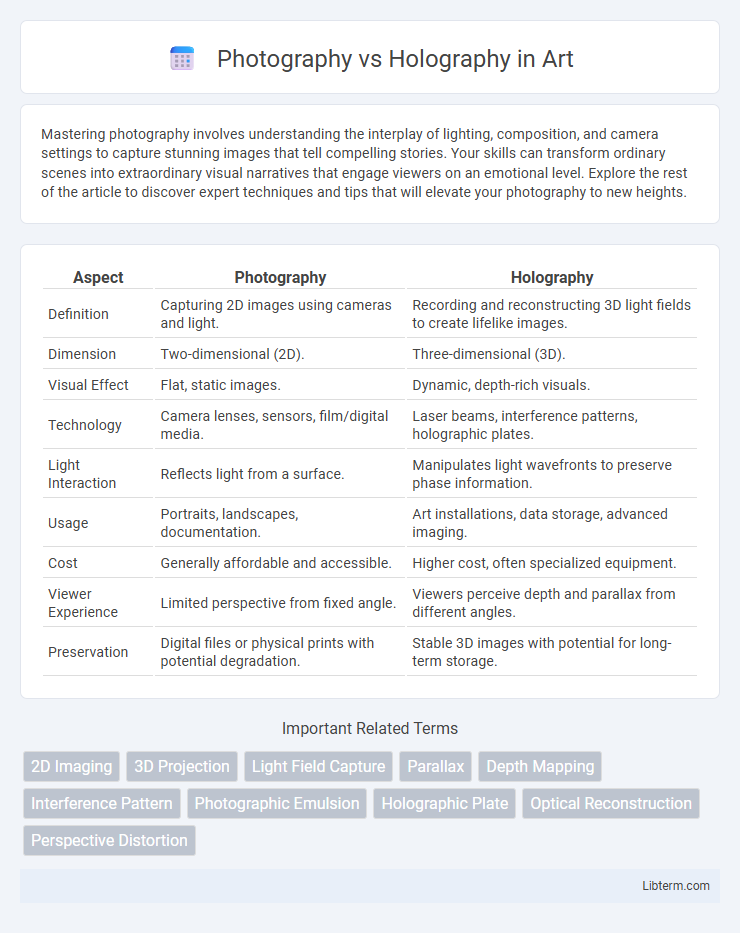Mastering photography involves understanding the interplay of lighting, composition, and camera settings to capture stunning images that tell compelling stories. Your skills can transform ordinary scenes into extraordinary visual narratives that engage viewers on an emotional level. Explore the rest of the article to discover expert techniques and tips that will elevate your photography to new heights.
Table of Comparison
| Aspect | Photography | Holography |
|---|---|---|
| Definition | Capturing 2D images using cameras and light. | Recording and reconstructing 3D light fields to create lifelike images. |
| Dimension | Two-dimensional (2D). | Three-dimensional (3D). |
| Visual Effect | Flat, static images. | Dynamic, depth-rich visuals. |
| Technology | Camera lenses, sensors, film/digital media. | Laser beams, interference patterns, holographic plates. |
| Light Interaction | Reflects light from a surface. | Manipulates light wavefronts to preserve phase information. |
| Usage | Portraits, landscapes, documentation. | Art installations, data storage, advanced imaging. |
| Cost | Generally affordable and accessible. | Higher cost, often specialized equipment. |
| Viewer Experience | Limited perspective from fixed angle. | Viewers perceive depth and parallax from different angles. |
| Preservation | Digital files or physical prints with potential degradation. | Stable 3D images with potential for long-term storage. |
Introduction to Photography and Holography
Photography captures real-world scenes by recording light on a photosensitive surface or sensor, creating two-dimensional images that represent moments in time. Holography records the light field reflected from objects, using laser beams and interference patterns to produce three-dimensional, lifelike images that can be viewed from multiple angles. Both techniques involve light manipulation but differ fundamentally in their methods and the dimensionality of their outputs.
Defining Photography: Techniques and Applications
Photography involves capturing images by recording light on a photosensitive surface or digital sensor, utilizing techniques such as exposure, aperture adjustment, and shutter speed control to achieve desired visual effects. Common applications include portraiture, landscape imaging, product photography, and documentary work, where two-dimensional representations capture moments and details with precision. Advances in digital technology have expanded photography's scope to include editing, enhancement, and distribution across various media platforms.
Understanding Holography: Principles and Methods
Holography utilizes laser light to record and reconstruct light wave patterns, capturing both amplitude and phase information for three-dimensional image creation, unlike traditional photography which only records two-dimensional intensity. The process involves splitting a coherent laser beam into reference and object beams, with the resulting interference pattern stored on a photosensitive medium, enabling depth perception and parallax in the hologram. Advanced techniques such as digital holography and phase-shifting methods enhance image resolution and accuracy, making holography vital in fields like data storage, microscopy, and security.
Historical Development: From Photography to Holography
Photography originated in the early 19th century with pioneers like Nicephore Niepce and Louis Daguerre, who developed techniques for capturing images on light-sensitive materials, fundamentally transforming visual documentation. Holography emerged in 1947 when Dennis Gabor introduced the concept of recording light wavefronts to create three-dimensional images, marking a significant advancement over traditional two-dimensional photography. This historical progression reflects a technological evolution from static image capture to dynamic spatial representation, expanding applications across art, science, and communication.
Technical Differences: 2D vs. 3D Imaging
Photography captures 2D images by recording light intensity and color on a flat surface, creating a single-plane representation. Holography records both the intensity and phase of light waves, reconstructing a fully three-dimensional image that retains depth and parallax. This fundamental technical difference enables holography to present lifelike 3D visuals, unlike traditional 2D photography.
Equipment and Technology Comparison
Photography relies on cameras using lenses and image sensors to capture two-dimensional static images through light reflection, while holography employs laser beams and beam splitters to record and reconstruct three-dimensional light fields. Cameras in photography typically utilize CMOS or CCD sensors, whereas holography requires coherent light sources like lasers and sensitive recording media such as photopolymer plates or digital holographic sensors. The technological complexity of holography demands precise environmental control and advanced optical components, contrasting with the relatively straightforward and widely accessible equipment used in traditional photography.
Image Quality and Realism
Photography captures images through light exposure on a sensor or film, producing two-dimensional representations with color accuracy and detail limited by resolution and sensor quality. Holography records light wave interference patterns, creating three-dimensional images that preserve depth, parallax, and realistic spatial information, enhancing immersion and lifelike appearance. While photography excels in sharpness and color fidelity, holography surpasses in realism by enabling dynamic viewing angles and true depth perception.
Practical Uses in Science, Art, and Industry
Photography captures static or dynamic images using light-sensitive materials or sensors, extensively used in scientific documentation and artistic expression for detailed visual records. Holography creates three-dimensional images through laser interference patterns, offering practical applications in industrial quality control, medical imaging, and augmented reality art installations. Both technologies enhance visualization but differ in dimensionality and interaction, with holography providing depth perception vital for precise industrial and medical uses.
Accessibility and Cost Considerations
Photography offers widespread accessibility due to affordable cameras and smartphones, making it an economical choice for capturing still images. Holography requires specialized equipment such as laser sources and recording materials, resulting in higher upfront costs and limited availability for general users. While photography remains cost-effective for everyday use, holography is predominantly utilized in industrial and scientific applications where budget and accessibility are less restrictive.
Future Prospects: Innovations in Imaging
Photography continues to evolve with advancements in computational imaging, AI-driven enhancement, and quantum sensor technology, offering higher resolution and dynamic range. Holography leverages breakthroughs in light field technology and augmented reality to create immersive, three-dimensional visual experiences with potential applications in telepresence and medical imaging. Both fields are converging towards hybrid imaging systems that combine the realism of photography with the depth and interactivity of holography, signaling a transformative future for visual media.
Photography Infographic

 libterm.com
libterm.com